|
Vanellus coronatus (Crowned
lapwing, Crowned plover)
Kroonkiewiet [Afrikaans]; Igxiya (also applied to
Black-winged lapwing [Xhosa]; iTitihoye (also applied to Senegal lapwing)
[Zulu]; Runkerenkere (generic term for lapwing) [Kwangali]; Lekekeruane,
Letletleruane [South Sotho]; Mororwane [North Sotho]; Hurekure [Shona];
Kelkelwane (generic for plovers) [Swazi]; Ghelekela (generic term for plover)
[Tsonga]; Lerweerwee, Lethęętsane, Lethęjane [Tswana]; Diadeemkievit [Dutch];
Vanneau couronné [French]; Kronenkiebitz [German]; Abibe-coroado [Portuguese]
Life
> Eukaryotes >
Opisthokonta
> Metazoa (animals) >
Bilateria >
Deuterostomia > Chordata >
Craniata > Vertebrata (vertebrates) > Gnathostomata (jawed
vertebrates) > Teleostomi (teleost fish) > Osteichthyes (bony fish) > Class:
Sarcopterygii (lobe-finned
fish) > Stegocephalia (terrestrial
vertebrates) > Tetrapoda
(four-legged vertebrates) > Reptiliomorpha > Amniota >
Reptilia (reptiles) >
Romeriida > Diapsida > Archosauromorpha > Archosauria >
Dinosauria
(dinosaurs) > Saurischia > Theropoda (bipedal predatory dinosaurs) >
Coelurosauria > Maniraptora > Aves
(birds) > Order: Charadriiformes
> Family: Charadriidae > Genus: Vanellus
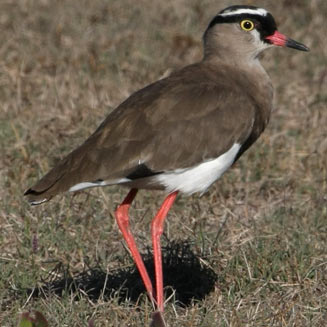 |
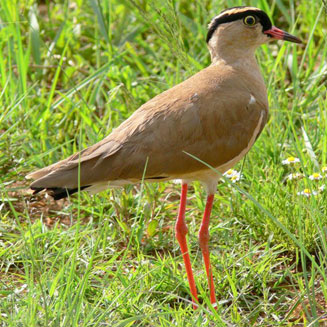 |
|
Crowned lapwing, De Hoop Nature Reserve.
[photo Duncan Robertson ©] |
Crowned lapwing, Kruger National Park, South
Africa. [photo
Tony Faria
©] |
Distribution and habitat
Occurs across much of sub-Saharan Africa; in southern
Africa it is common in Namibia, Botswana, Zimbabwe, northern and south-western
South Africa and southern Mozambique.
It generally prefers dry, open grassland, sparse woodland, open areas in Karoo
scrub and man-made habitats, such as open fields, short pastures, airports, golf
courses and roadsides.
|
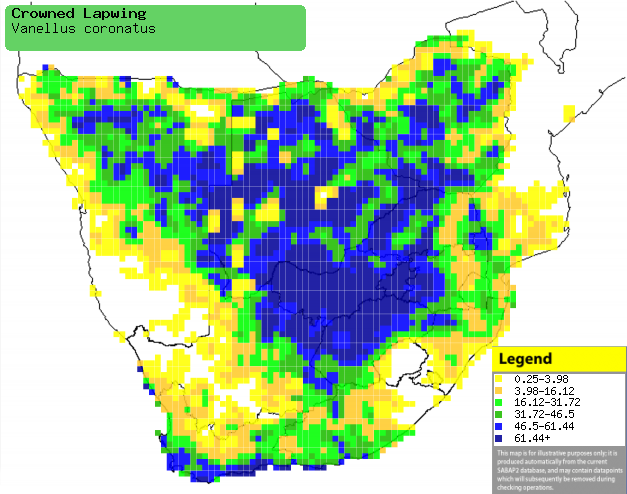 |
|
Distribution of Crowned lapwing in southern Africa,
based on statistical smoothing of the records from first SA Bird Atlas
Project (©
Animal Demography unit, University of
Cape Town; smoothing by Birgit Erni and Francesca Little). Colours range
from dark blue (most common) through to yellow (least common).
See here for the latest distribution
from the SABAP2. |
Predators and parasites
- Predators
- of adults
- of both chicks and eggs
- of eggs
- of chicks
Movements and migrations
Mainly resident and sedentary, although it may
move in response to changing habitat conditions, such as if grass
grows to long.
Food
It mainly eats termites (which make up approximately 80-90% of
its diet), using the typical foraging technique of plovers, running, stopping
then searching for prey on the ground. It often forages in groups, sometimes
alongside Black-winged lapwings, moving
in a regularly spaced line. The following food items have been recorded
in its diet:
Breeding
- Usually a monogamous, territorial solitary nester, although polygamy is
rarely recorded. It often breeds in loose groups, sometimes along with
Black-winged lapwings and
Spotted thick-knees, so
that they can work together to alert each other to the presence of predators,
and subsequently mob them together.
- The nest (see image below) is a scrape in the ground, lined with dried
grass, roots, small stones and dried dung and typically placed on bare ground
or among short vegetation, sometimes adjacent to a stone or mound of earth.
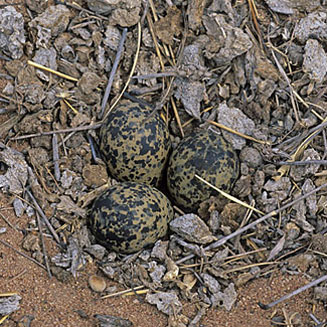 |
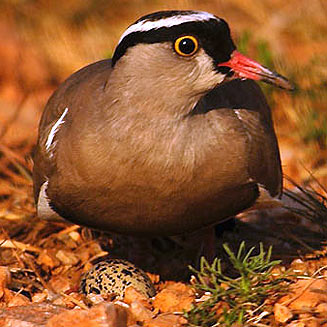 |
|
Crowned lapwing nest with eggs, Sericea
farm, South Africa. [photo Warwick Tarboton ©] |
Crowned lapwing on nest, South Africa. [photo Callie de Wet ©] |
- Egg-laying season is year-round, peaking from August-December.
- It lays 2-4 eggs, which are mainly incubated by the female, although the
male occasionally takes over if it gets particularly hot.
- The chicks leave the nest after about four hours, once their down is
dry; the adults take turns in caring for the chicks and directing them to
food items, so that the parent not on duty can feed. If a predator
approaches, the parent on guard performs a distraction display while the
young find somewhere to hide. They eventually fledge at about 29-31 days
old, becoming fully independent at the onset of the following
breeding season, a year later.
Threats
Not threatened, in fact its range and numbers have been
increasing, as it has benefited from the modification of habitats by humans.
References
-
Hockey PAR, Dean WRJ and Ryan PG 2005. Roberts
- Birds of southern Africa, VIIth ed. The Trustees of the John Voelcker
Bird Book Fund, Cape Town.
|
